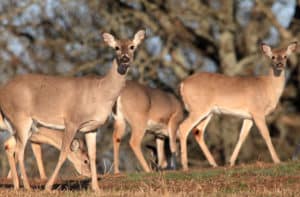Tens of thousands of orange-clad hunters will hit the woods on SaturdayBy KELLY BOSTIAN
For the CCOF The heart of Oklahoma’s deer season opens Saturday with a new twist and hope for a new trend to emerge. While the archery season runs Oct. 1-Jan. 15 and muzzleloader hunters hit the woods a couple of weeks ago, rifle season marks the major parade of blaze orange into the woods. It is also the season that accounts for the majority of the annual harvest. More than 218,000 hunters took advantage of the gun, youth gun, and holiday antlerless gun seasons in 2020. Those hunters reported a total kill of 73,542 deer, according to the Oklahoma Department of Wildlife Conservation’s annual Big Game Harvest Report. Both of those numbers are annual records. The deer gun season is open Nov. 20-Dec. 5 and the holiday antlerless season runs Dec. 18-31. The twist is that few, if any, expected the autumn 2021 white-tailed deer season to include talk of COVID-19, at least not in the deer population. The more expected factor is the potential to see a repeat of more does among the statewide harvest. New bag limits started last season seemed to make a difference, said Dallas Barber, big game biologist for the Wildlife Department. Biologists have long asked for more hunters to harvest more does to help with population dynamics. New bag limits that allowed for hunters to take more does in the rifle season and in a longer antlerless-only season around the Christmas holiday likely contributed to the state hitting the long-desired goal last year, he said. For the entire state, 43 percent of deer killed were antlerless deer, the greatest percentage since 2010. It was the first time since 2015 that harvest met the goal of 40 to 45 percent. “We’re very proud of our hunters for hanging in and getting that antlerless harvest up where it needs to be,” Barber said. Reducing the doe population to a ratio that is more even with the buck population helps the health of the deer overall, he said. It allows the typically fewer number bucks to mate with a greater percentage of female deer during a first cycle in early November. Does that do not mate will cycle again, and that extends the stressful breeding period for bucks. It also means those late pregnancies will lead to late-born fawns that are at a disadvantage for summer growth and survival the following winter. The true surprise for the 2021 season is COVID-19 in the wild deer population, something found in a wide range of states this fall, according to a report issued by the U.S. Department of Agriculture. “We do have some deer with tests that came back positive for COVID,” Barber said. “We don’t know how, we don’t know why, and we don’t know when those infections happened.” A regular annual herd health evaluation of 40 to 80 deer sampled from rotating areas of the state revealed the results. COVID testing was not planned, he said. After a handful of Northeastern states documented COVID in deer, the lab offered to test Oklahoma blood samples as well. Not much is known at this point, but Barber said no documentation shows that deer can transmit the virus to humans. He recommended using standard precautions hunters practice when field-dressing their deer. Deer are potential vectors for several diseases but Covid was a surprise that caught people’s attention, he said. “Wear rubber gloves and take the same precautions you should be taking to begin with,” he said.
0 Comments
Leave a Reply. |
Archives
May 2024
Categories
All
|
Conservation Coalition of Oklahoma
P.O. Box 2751
Oklahoma City, OK 73101
[email protected]



